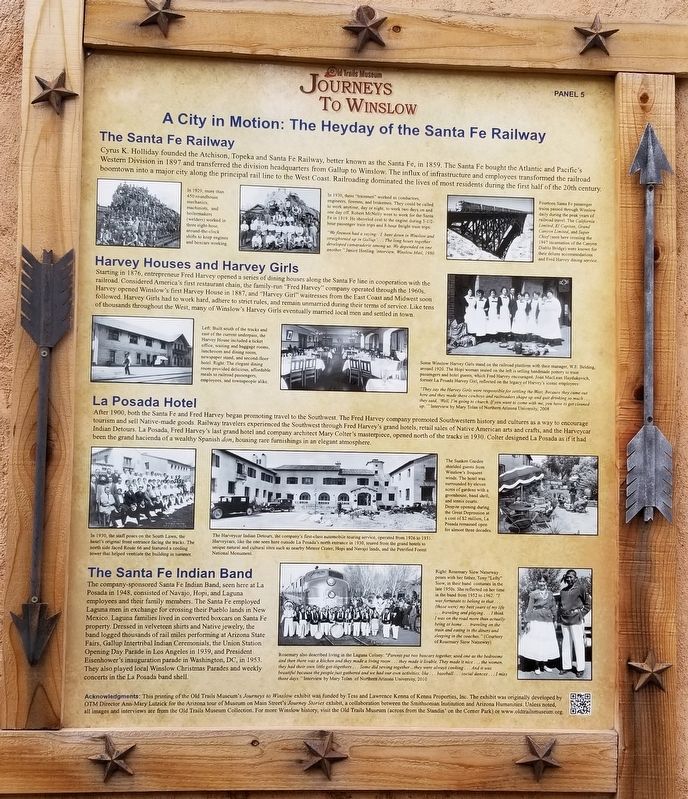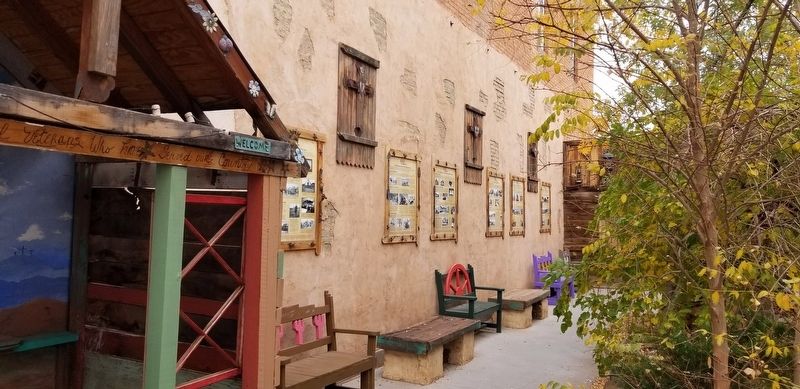Winslow in Navajo County, Arizona — The American Mountains (Southwest)
A City in Motion: The Heyday of the Santa Fe Railway
Journeys to Winslow
Inscription.
The Santa Fe Railway
Cyrus K. Holliday founded the Atchison, Topeka and Santa Fe Railway, better known as the Santa Fe, in 1859. The Santa Fe bought the Atlantic and Pacific's Western Division in 1897 and transferred the division headquarters from Gallup to Winslow. The influx of infrastructure and employees transformed the railroad boomtown into a major city along the principal rail line to the West Coast. Railroading dominated the lives of most residents during the first half of the 20th century.
Harvey Houses and Harvey Girls
Starting in 1876, entrepreneur Fred Harvey opened a series of dining houses along the Santa Fe line in cooperation with the railroad. Considered America's first restaurant chain, the family-run "Fred Harvey" company operated through the 1960s. Harvey opened Winslow's first Harvey House in 1887, and "Harvey Girl" waitresses from the East Coast and Midwest soon followed. Harvey Girls had to work hard, adhere to strict rules, and remain unmarried during their terms of service. Like tens of thousands throughout the West, many of Winslow's Harvey Girls eventually married local men and settled in town.
La Posada Hotel
After 1900, both the Santa Fe and Fred Harvey began promoting travel to the Southwest. The Fred Harvey company promoted Southwestern history and cultures as a way to encourage tourism and sell Native-made goods. Railway travelers experienced the Southwest through Fred Harvey's grand hotels, retail sales of Native American arts and crafts, and the Harveycar Indian Detours. La Posada, Fred Harvey's last grand hotel and company architect Mary Colter's masterpiece, opened north of the tracks in 1930. Colter designed La Posada as if it had been the grand hacienda of a wealthy Spanish don , housing rare furnishings in an elegant atmosphere.
The Santa Fe Indian Band
The company-sponsored Santa Fe Indian Band, seen here at La Posada in 1948, consisted of Navajo, Hopi, and Laguna employees and their family members. The Santa Fe employed Laguna men in exchange for crossing their Pueblo lands in New Mexico. Laguna families lived in converted boxcars on Santa Fe property. Dressed in velveteen shirts and Native jewelry, the band logged thousands of rail miles performing at Arizona State Fairs, Gallup Intertribal Indian Ceremonials, the Union Station Opening Day Parade in Los Angeles in 1939, and President Eisenhower's inauguration parade in Washington, DC, in 1953. They also played local Winslow Christmas Parades and weekly concerts in the La Posada band shell.
Captions
Upper Left: In 1929, more than 450 roundhouse mechanics, machinists, and boilermakers (welders)
worked in three eight-hour, around-the-clock shifts to keep engines and boxcars working
Upper Middle: In 1930, these "trainmen" worked as conductors, engineers, firemen, and brakemen. They could be called to work anytime, day or night, to work two days on and one day off. Robert McNelly went to work for the Santa Fe in 1919. He shoveled coal to the engine during 3-1/2 hour passenger train trips and 8-hour freight train trips: "We firemen had a saying: 'I bent down in Winslow and straightened up in Gallup' … The long hours together developed camaraderie among us. We depended on one another." Janice Henling interview, Winslow Mail, 1980
Upper Right: Fourteen Santa Fe passenger trains passed through Winslow daily during the peak years of railroad travel. The California Limited, El Capitan, Grand Canyon Limited, and Super Chief (seen here crossing the 1947 incarnation of the Canyon Diablo Bridge) were known for their deluxe accommodations and Fred Harvey dining service.
Middle Left: Left: Built south of the tracks and east of the current underpass, the Harvey House included a ticket office, waiting and baggage rooms, lunchroom and dining room, newspaper stand, and second-floor hotel. Right: The elegant dining room provided delicious, affordable meals to railroad passengers, employees, and townspeople alike.
Middle Right: Some Winslow Harvey Girls stand on the railroad platform with their manager, W.E. Belding, around 1920. The Hopi woman seated on the left is selling handmade pottery to train passengers and hotel guests, which Fred Harvey encouraged. Jean MacLean Haydukovich, former La Posada Harvey Girl, reflected on the legacy of Harvey's iconic employees: "They say the Harvey Girls were responsible for settling the West. Because they came out here and they made these cowboys and railroaders shape up and quit drinking so much they said, 'Well, I'm going to church. If you want to come with me, you have to get cleaned up." Interview by Mary Tolan of Northern Arizona University, 2008
Lower Middle Left: In 1930, the staff poses on the South Lawn, the hotel's original front entrance facing the tracks. The north side faced Route 66 and featured a cooling tower that helped ventilate the building in summer.
Lower Middle Center: The Harveycar Indian Detours, the company's first-class automobile touring service, operated from 1926 to 1931. Harveycars, like the one seen here outside La Posada's north entrance in 1930, toured from the grand hotels to unique natural and cultural sites such as nearby Meteor Crater, Hopi and Navajo lands, and the Petrified Forest National Monument.
Lower Middle Right: The Sunken Garden shielded guests from Winslow's frequent winds. The hotel was surrounded by eleven acres of gardens with a greenhouse, band shell, and tennis courts. Despite opening during the Great Depression at a cost of $2 million, La Posada remained open for almost three decades.
Lower Right: Right: Rosemary Siow Natseway poses with her father, Tony "Lefty" Siow, in their band costumes in the late 1950s. She reflected on her time in the band from 1952 to 1962 "I was fortunate to belong to that … (those were) my best years of my life traveling and playing ... I think I was on the road more than actually being at home … traveling on the train and eating in the diners and sleeping in the coaches." (Courtesy of Rosemary Siow Natseway)
Rosemary also described living in the Laguna Colony: "Parents put two boxcars together, used one as the bedrooms and then there was a kitchen and they made a living room … they made it livable. They made it nice … the women, they had their own little get-togethers … Some did sewing together … they were always cooking. And it was beautiful because the people just gathered and we had our own activities, like... baseball... social dances...I miss those days." Interview by Mary Tolan of Northern Arizona University, 2010
Acknowledgments: This printing of the Old Trails Museum's Journeys to Winslow exhibit was funded by Tess and Lawrence Kenna. The exhibit was originally developed by OTM Director Ann-Mary Lutzick for the Arizona tour of Museum on Main Street's Journey Stories exhibit, a collaboration between the Smithsonian Institution and Arizona Humanities. Unless noted, all images and interviews are from the Old Trails Museum Collection. For more Winslow history, visit the Old Trails Museum (across from the Standin' on the Corner Park) or www.oldtrailsmuseum.org.
Erected 2017 by Old Trails Museum - Winslow Historical Society. (Marker Number 5.)
Topics. This historical marker is listed in these topic lists: Entertainment • Industry & Commerce • Native Americans • Railroads & Streetcars. A significant historical year for this entry is 1859.
Location. 35° 1.396′ N, 110° 41.842′ W. Marker is in Winslow, Arizona, in Navajo County. Marker can be reached from East 2nd Street, 0.1 miles east of North Kinsley Avenue. The marker is located in an alley way between two buildings. Touch for map. Marker is at or near this postal address: 116 East 2nd Street, Winslow AZ 86047, United States of America. Touch for directions.
Other nearby markers. At least 8 other markers are within walking distance of this marker. A City in Motion: Modern Modes (here, next to this marker); Winslow Today: Commerce and Employment (here, next to this marker); The Railroads Build a Town: Early Industry (here, next to this marker); The Railroads Build a Town: Early Days (here, next to this marker); Winslow Today: Downtown Renaissance and Tourism (here, next to this marker); The First Peoples of the Southwestern Colorado Plateau (a few steps from this marker); Early Trails Across the Little Colorado River Valley (a few steps from this marker); Standin’ on the Corner Park, Winslow, Arizona (within shouting distance of this marker). Touch for a list and map of all markers in Winslow.
Also see . . . Journeys to Winslow. Old Trails Museum - Winslow Historical Society
The Old Trails Museum debuted the Journeys to Winslow exhibit in October 2017 in the Skylark Courtyard, which is a stop along the Journey Through Winslow Pathway. Developed by Tess and Lawrence Kenna, the Pathway is a trail for residents and visitors to explore Winslow’s history and current downtown revitalization, and its other stops include the World’s Smallest Church on Route 66 and historic facades and murals throughout the downtown historic district. The Kennas funded the reprinting of Journeys to Winslow, which was originally developed by the Old Trails Museum for the Winslow stop on the Arizona tour of the Smithsonian’s Journey Stories exhibition (above at the Grand Opening at La Posada Hotel in June 2013).(Submitted on November 8, 2022, by James Hulse of Medina, Texas.)
Credits. This page was last revised on November 8, 2022. It was originally submitted on November 8, 2022, by James Hulse of Medina, Texas. This page has been viewed 203 times since then and 46 times this year. Photos: 1, 2. submitted on November 8, 2022, by James Hulse of Medina, Texas.

